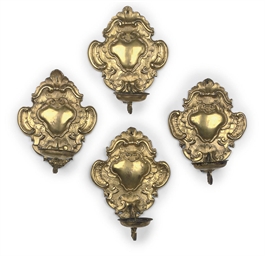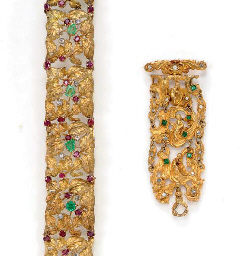A SET OF REPOUSSÉ PARCEL-GILT SILVER SADDLE ORNAMENTSYuan Dynasty
Designed as coverings for the pommel and cantle, each worked in repoussé with a central quatrefoil enclosing a winged creature, the larger pommel cover featuring a pair of winged makara dragon-fish over scrolling mist, the smaller cantle cover with a single phoenix soaring over scrolling clouds, each broad side rimmed with a keyfret border followed by a gilt-embellished scrolling border, the upper edge and narrow sides hammered flat and perforated for attachment.
7 x 5 3/4in (17.8 x 14.6cm) and 7 1/8 x 5in (18.3 x 12.7cm) (2).Footnotes元 鎏金捶揲銀鞍橋飾一組
Provenance:
Shirley Day Ltd., London, 15 February 2000
Exhibited:
Beyond the Great Wall: Cultural Features of China's Cowboy Neighbors, Museum of Fine Arts, Houston, 22 November 2003 - 29 February 2004
Published:
Bunker, Emma, Beyond the Great Wall: Cultural Features of China's Cowboy Neighbors (exhibition pamphlet), Museum of Fine Arts, Houston, 2003, p. 2
來源:
倫敦Shirley Day Ltd.古董行,2000年2月15日
展覽:
Beyond the Great Wall: Cultural Features of China's Cowboy Neighbors,休斯敦美術館,2003年11月22日 - 2004年2月29日
出版:
Emma Bunker著,Beyond the Great Wall: Cultural Features of China's Cowboy Neighbors (導覽手冊),休斯敦美術館,2003年,頁2
In Northern China, gilt-metal saddle arches designed to fit on the pommel and cantle can be traced to at least the Former Yan (337-370) dynasty of the Sixteen Kingdoms period (304-439), when the Murong Xianbei nomadic group ruled a large region in Northern China. A pair of openwork gilt-bronze saddle arches featuring deer, birds, and mythical creatures (some of which suggest contact with Central Asia) were excavated in 1988 near modern-day Chaoyang, Liaoning province and are now housed in the Liaoning Institute of Archaeology. These early arches were included in the exhibition and catalogue, China: Dawn of a Golden Age, 200-750 AD, The Metropolitan Museum of Art, New York, 2004, pp. 125-125, cat. no. 25.
The tradition enjoyed a renaissance in the same regions in the Liao (916-1125) and Yuan (1279-1368) dynasties, when China was again ruled by historically nomadic groups. Liao saddle covers tend to be narrower and have a high arched form. See, for example, a pair of gilt-silver saddle covers decorated with soaring birds excavated from the tomb of Xiao Shaoju (d. 1018) in Qinglongshan, Naiman Banner, Inner Mongolia, and included in the exhibition Gilded Splendor: Treasures of China's Liao Empire (907-1125, Asia Society, New York, 2006, pp. 122-123, cat. no. 12a-d. These were attached to a wooden saddle frame along with related gilt-metal saddle ornaments, suggesting that they were made specifically for a funereal context. Another pair of silver saddle arches, but featuring a pair of phoenix in repoussé and gilt from the Mengdiexuan Collection, were included in the exhibition Hunters, Warriors, Spirits: Nomadic Art of North China, Indra and Harry Banga Gallery, City University of Hong Kong, Hong Kong, 21 July - 23 October 2022, and are featured on the exhibition website.
During the Mongol empire, gold and gilt-silver saddle arches developed a more rectangular shape and were found in tombs across Northern China, the 'Golden Horde' regions of Mongolia and Russia, and Central Asia. These would also have been fitted to wood pommels and cantles and used by Mongol nobility, with gold versions reserved for the ruler and his family, and gilt-silver version used by lesser nobility (Linda Komaroff and Stefano Carboni (eds), The Legacy of Genghis Khan: Courtly Art and Culture in Western Asia, 1256-1353, The Metropolitan Museum of Art, New York, 2002, pp. 272-273). Such fittings were likely used during important hunts and parades (ibid., p. 273). See for example, a pair of gilt-silver saddle arches of similar form to the present set, but with the central designs featuring rabbits and horses, excavated from Golden Horde site dating to the first half of the 13th century in the Molochnaya River in southern Ukraine, and now in the collection of the State Hermitage Museum, Saint Petersburg (coll. nos ChM-1199, -1200), and illustrated in ibid., pp. 66, 272-273, fig. 63, cat. no. 138. For a similarly shaped pommel cover worked completely in gold sheet with a central deer in repoussé, excavated from the 13th-14th century tomb of a teenage girl at Baogedu Wusumu Hashtugacha, Xilingguoli League, Xianghuang Banner, Inner Mongolia, and now in the collection of the Inner Mongolian Museum, Huhehaote, see Adam T. Kessler, Empires Beyond the Great Wall: The Heritage of Genghis Khan, Natural History Museum of Los Angeles County, Los Angeles, 1993, p. 155, fig. 101.
The design of the makara on the present saddle arches closely resembles the style of fish on contemporaneous Mongolian metalworks, for instance, the repoussé fish-form handles of a gold cup, excavated from a late 13th-14th century Golden Horde site at Saray al-Jadid (modern Tzarevo Gorodishe), and now in the collection of the State Hermitage Museum, Saint Petersburg (coll. no. SAR-1613) and illustrated in The Legacy of Genghis Khan, op. cit. pp. 18, 273, fig. 11, cat. no. 139.
A SET OF REPOUSSÉ PARCEL-GILT SILVER SADDLE ORNAMENTSYuan Dynasty
Designed as coverings for the pommel and cantle, each worked in repoussé with a central quatrefoil enclosing a winged creature, the larger pommel cover featuring a pair of winged makara dragon-fish over scrolling mist, the smaller cantle cover with a single phoenix soaring over scrolling clouds, each broad side rimmed with a keyfret border followed by a gilt-embellished scrolling border, the upper edge and narrow sides hammered flat and perforated for attachment.
7 x 5 3/4in (17.8 x 14.6cm) and 7 1/8 x 5in (18.3 x 12.7cm) (2).Footnotes元 鎏金捶揲銀鞍橋飾一組
Provenance:
Shirley Day Ltd., London, 15 February 2000
Exhibited:
Beyond the Great Wall: Cultural Features of China's Cowboy Neighbors, Museum of Fine Arts, Houston, 22 November 2003 - 29 February 2004
Published:
Bunker, Emma, Beyond the Great Wall: Cultural Features of China's Cowboy Neighbors (exhibition pamphlet), Museum of Fine Arts, Houston, 2003, p. 2
來源:
倫敦Shirley Day Ltd.古董行,2000年2月15日
展覽:
Beyond the Great Wall: Cultural Features of China's Cowboy Neighbors,休斯敦美術館,2003年11月22日 - 2004年2月29日
出版:
Emma Bunker著,Beyond the Great Wall: Cultural Features of China's Cowboy Neighbors (導覽手冊),休斯敦美術館,2003年,頁2
In Northern China, gilt-metal saddle arches designed to fit on the pommel and cantle can be traced to at least the Former Yan (337-370) dynasty of the Sixteen Kingdoms period (304-439), when the Murong Xianbei nomadic group ruled a large region in Northern China. A pair of openwork gilt-bronze saddle arches featuring deer, birds, and mythical creatures (some of which suggest contact with Central Asia) were excavated in 1988 near modern-day Chaoyang, Liaoning province and are now housed in the Liaoning Institute of Archaeology. These early arches were included in the exhibition and catalogue, China: Dawn of a Golden Age, 200-750 AD, The Metropolitan Museum of Art, New York, 2004, pp. 125-125, cat. no. 25.
The tradition enjoyed a renaissance in the same regions in the Liao (916-1125) and Yuan (1279-1368) dynasties, when China was again ruled by historically nomadic groups. Liao saddle covers tend to be narrower and have a high arched form. See, for example, a pair of gilt-silver saddle covers decorated with soaring birds excavated from the tomb of Xiao Shaoju (d. 1018) in Qinglongshan, Naiman Banner, Inner Mongolia, and included in the exhibition Gilded Splendor: Treasures of China's Liao Empire (907-1125, Asia Society, New York, 2006, pp. 122-123, cat. no. 12a-d. These were attached to a wooden saddle frame along with related gilt-metal saddle ornaments, suggesting that they were made specifically for a funereal context. Another pair of silver saddle arches, but featuring a pair of phoenix in repoussé and gilt from the Mengdiexuan Collection, were included in the exhibition Hunters, Warriors, Spirits: Nomadic Art of North China, Indra and Harry Banga Gallery, City University of Hong Kong, Hong Kong, 21 July - 23 October 2022, and are featured on the exhibition website.
During the Mongol empire, gold and gilt-silver saddle arches developed a more rectangular shape and were found in tombs across Northern China, the 'Golden Horde' regions of Mongolia and Russia, and Central Asia. These would also have been fitted to wood pommels and cantles and used by Mongol nobility, with gold versions reserved for the ruler and his family, and gilt-silver version used by lesser nobility (Linda Komaroff and Stefano Carboni (eds), The Legacy of Genghis Khan: Courtly Art and Culture in Western Asia, 1256-1353, The Metropolitan Museum of Art, New York, 2002, pp. 272-273). Such fittings were likely used during important hunts and parades (ibid., p. 273). See for example, a pair of gilt-silver saddle arches of similar form to the present set, but with the central designs featuring rabbits and horses, excavated from Golden Horde site dating to the first half of the 13th century in the Molochnaya River in southern Ukraine, and now in the collection of the State Hermitage Museum, Saint Petersburg (coll. nos ChM-1199, -1200), and illustrated in ibid., pp. 66, 272-273, fig. 63, cat. no. 138. For a similarly shaped pommel cover worked completely in gold sheet with a central deer in repoussé, excavated from the 13th-14th century tomb of a teenage girl at Baogedu Wusumu Hashtugacha, Xilingguoli League, Xianghuang Banner, Inner Mongolia, and now in the collection of the Inner Mongolian Museum, Huhehaote, see Adam T. Kessler, Empires Beyond the Great Wall: The Heritage of Genghis Khan, Natural History Museum of Los Angeles County, Los Angeles, 1993, p. 155, fig. 101.
The design of the makara on the present saddle arches closely resembles the style of fish on contemporaneous Mongolian metalworks, for instance, the repoussé fish-form handles of a gold cup, excavated from a late 13th-14th century Golden Horde site at Saray al-Jadid (modern Tzarevo Gorodishe), and now in the collection of the State Hermitage Museum, Saint Petersburg (coll. no. SAR-1613) and illustrated in The Legacy of Genghis Khan, op. cit. pp. 18, 273, fig. 11, cat. no. 139.















Testen Sie LotSearch und seine Premium-Features 7 Tage - ohne Kosten!
Lassen Sie sich automatisch über neue Objekte in kommenden Auktionen benachrichtigen.
Suchauftrag anlegen